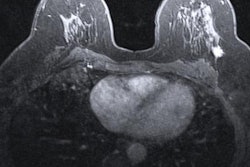
Supplemental screening with MRI is a good tool for detecting interval cancers in women with a personal history of breast cancer, with several patient characteristics linked to likelihood of cancer, according to research published June 8 in Radiology.
A group of researchers led by Dr. Ga Ram Kim from Seoul National University Hospital in South Korea found that MRI may be more effective in detecting early recurrent breast cancers and preventing advanced-stage interval cancers than mammography in women with a personal history of breast cancer.
"Our results could provide valuable information to establish risk-based surveillance strategies for women with a personal history of breast cancer," the authors wrote.
There is some controversy as to the role of breast screening MRI for women with a personal history of breast cancer. Although annual mammography and physical examinations are recommended for surveillance, breast MRI has been shown to improve the detection of early-stage breast cancer that may be missed by mammograms.
But few studies have been performed on the value of screening breast MRI to detect interval cancer in women with a personal history of breast cancer. So, the research team wanted to evaluate performance measures of screening breast MRI in women with a personal history of breast cancer across multiple rounds and identify subgroups who might be more at risk for interval cancers.
They found that interval cancers were associated with the following factors.
| Factors associated with interval cancers on breast MRI exams | |
| Factor | Odds ratio of interval cancer |
| Moderate or marked background parenchymal enhancement | 10.8 |
| First-degree family history of breast cancer | 5.4 |
| Estrogen receptor and progesterone receptor-negative primary cancers | 3.6 |
The median interval between initial cancer surgery and detection of second breast cancer was three years. The median interval meanwhile between a prior negative MRI result and the detection of interval cancer was 6.6 months.
"We can infer that aggressive primary breast cancer hampers the detection of second cancers at subsequent screening because of its rapid growth," the authors wrote. "Thus, tailored surveillance guidelines accounting for the characteristics of primary breast cancer and [background parenchymal enhancement] on MRI scans might be beneficial for women with a personal history of breast cancer."
Among the 6,603 MRI examinations for 2,809 Asian women with a median age of 47 years, the cancer detection rate was 8.3 per 1,000 screening examinations. The interval cancer rate meanwhile was 1.5 per 1,000 screening examinations, higher than the 0 to 0.83 per 1,000 examinations in MRI screening studies of women with average risk or extremely dense breast tissue. Breast MRI had a sensitivity of 85% and a specificity of 88.3%.
However, MRI fell short of detecting as many interval cancers as mammography in women with a personal history of breast cancer. While MRI had an interval cancer rate of 1.5 per 1,000 screenings, mammography had a rate of 3.5 to 3.6 interval cancers per 1,000 screenings.
Despite this, the researchers wrote that their finding of interval cancers being mostly early-stage cancers suggests that supplemental screening MRI is more effective than mammography.
The authors said that because most interval cancers were asymptomatic recurrences, "whether detection of these cancers is truly beneficial or harmful should be evaluated in future research."



.fFmgij6Hin.png?auto=compress%2Cformat&fit=crop&h=100&q=70&w=100)





.fFmgij6Hin.png?auto=compress%2Cformat&fit=crop&h=167&q=70&w=250)











